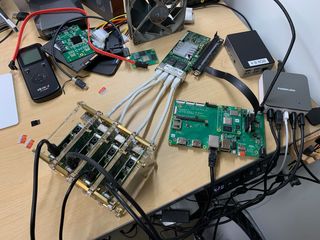
In a recent tweet, Raspberry Pi expert and enthusiast Jeff Geerling announced that after much work, he managed to get an Intel I340-T4 4x Gigabit NIC working with the Raspberry Pi Compute Module 4 using a Compute Module 4 I/O board.
After everything was said and done, Geerling was able to record a maximum performance throughput of 3.06 Gbps.
Connecting the hardware was easy enough but still came with a bit of a challenge The Compute Module 4 I/O board has a 1x slot, but the card uses a 4x plug. Geerling easily bridged the connection with a 1x to 16x PCIe adapter.

It took a some work to determine the best route for driver installation, but the maker found a solution and tested the final setup using four individual Raspberry Pis (one for each port on the card). When testing the performance individually, they averaged around 940 Mbps. Altogether, the throughput maxed out at 3.06 Gbps.
The process is much more involved than we covered here. You can read a detailed explanation behind the construction and setup of this project on Jeff Geerling's website.
Stay on the Cutting Edge
Join the experts who read Tom's Hardware for the inside track on enthusiast PC tech news — and have for over 25 years. We'll send breaking news and in-depth reviews of CPUs, GPUs, AI, maker hardware and more straight to your inbox.

Ash Hill is a Freelance News and Features Writer with a wealth of experience in the hobby electronics, 3D printing and PCs. She manages the Pi projects of the month and much of our daily Raspberry Pi reporting while also finding the best coupons and deals on all tech.
-
Zoe Alexis A question, why the need for all the NIC cards? I don't think that the Pi really has the computing power to process the incoming NIC data. I mean to actually do something useful with it. It's great that the system has a bandwidth of 3 Gb/s, the bottleneck will be trying to process this incoming data in real time. Even saving it to disk will be time consuming. Besides this, the Pi has a USB3 port. An USB to Ethernet converter can be used should more than one NIC be required. Or even a network switch. When serious data analysis is required in real time, custom hardware is often the best, but unfortunately the most expensive solution. Parallel processing using FPGAs. These are my thoughts, I'm trying to understand why all those NICs would be beneficial. Zoe.Reply -
somerandomscandinavian ReplyZoe Alexis said:A question, why the need for all the NIC cards? I don't think that the Pi really has the computing power to process the incoming NIC data. I mean to actually do something useful with it. It's great that the system has a bandwidth of 3 Gb/s, the bottleneck will be trying to process this incoming data in real time. Even saving it to disk will be time consuming. Besides this, the Pi has a USB3 port. An USB to Ethernet converter can be used should more than one NIC be required. Or even a network switch. When serious data analysis is required in real time, custom hardware is often the best, but unfortunately the most expensive solution. Parallel processing using FPGAs. These are my thoughts, I'm trying to understand why all those NICs would be beneficial. Zoe.
If you read his home page, there is a section at the end with the headline "What do you do with this thing", where it is written that PfSense or Openwrt could be an option. If you are unfamiliar with what these are, they are router, firewall and switching software which can replace your existing router to allow for more granular control or more features. While Openwrt could run on basically everything (because it's based on Linux), PfSense is different. PfSense is based on FreeBSD which has less compatibility with for instance Realtek network drivers which is fairly common in smaller computer and tinkering boards. Intel is regarded as the safest option when it comes to stability, performance and features in FreeBSD, hence why this project is interested for the masses who want a low-powered and compact platform to run their router/firewall on.
Most Popular


